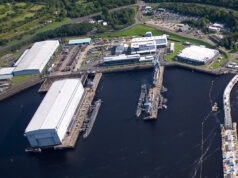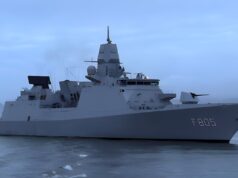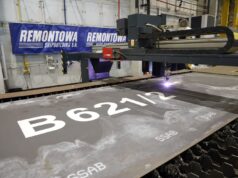The Submarine Delivery Agency (SDA) and Babcock have achieved a significant milestone in their ongoing submarine decommissioning efforts.
The SDA recently shared on their official Twitter account: “Swiftsure was dry-docked in Rosyth to begin preparations for final dismantling. Swiftsure is being used as a demonstrator and will be the first UK nuclear-powered submarine to be fully dismantled by the end of 2026.”
This will be done in a way that has not been attempted by any other nation.
Around 90% of components, including valuable steel can be reused or recycled. [2/2]#SDA #Submarines
— Submarine Delivery Agency (@SDA_mod) August 9, 2023
Notably, this dismantling process is set to be unique, as highlighted by the SDA’s statement: “This will be done in a way that has not been attempted by any other nation. Around 90% of components, including valuable steel can be reused or recycled.”
Furthermore, the SDA emphasised their commitment to safety and environmental responsibility, noting that they are leading the way for safe disposal of all ex-service nuclear submarines.
Their statement added, “Our progress includes completing the first stage of dismantling, with Low-Level radioactive waste removed on the submarines Swiftsure, Resolution, Revenge and Repulse.”
The agency also proudly revealed their safety record, mentioning that this accomplishment was achieved alongside a staggering “million hours of work without a safety incident.”
Additionally, in response to a Parliamentary Written Question earlier this year, the Ministry of Defence offered insights into the status of the decommissioning of the UK’s nuclear submarines.
James Cartlidge, the Minister of State for the Ministry of Defence, responded to the inquiry, saying, “Good progress continues to be made with dismantling decommissioned submarines in Rosyth. The first stage of dismantling, including the removal of all Low-Level radioactive Waste, has been completed on four platforms, Swiftsure, Resolution, Revenge, and Repulse.”
Cartlidge also confirmed that Swiftsure will be the first submarine to be fully dismantled by the end of 2026. As of June 1, 2023, the UK has 22 decommissioned submarines awaiting disposal.














Well there appears to be plenty work for them if successful
At the current rate which is even slower than the build rate I’m not sure we will ever finish this task.
It’s criminal it’s taken so long to even attempt this.
I believe they are building a disposal facility in Devonport, so that will help speed things up.
Yes….like all MoD projects it takes much longer than you think. If you think of a period that seems too long…..then double it
All ships and subs should be recycled in the yard they were built in. For example a yard could build 3 new vessels and recycle 3 old ones every 5 years with each one having a service life of 30 years. That gives us a fleet of 18 vessels and a permanant production line.
The white line on the hull is a quick and easy indicator to see if the Hull is flooding when it’s in the basin. If you cannot see it from the jetty because its underwater you have a problem!
Simple solutions, they usually work the best
It’s good that they are finally getting to grips with this..90% recycling is pretty good going,
Some of us know why swiftsure is first.
So there will be nothing left when Finished? Are no bits going to need to go into storage? I’ve not read up enough about it.
The steel will be melted down and turned into structural “H” bars for construction. Some of it might be rolled into baked beans cans after being coated with tin. The dregs might be used for rebar. Stainless steel delivered to a Glasgow scrap metal yard will fetch £0.87 – £0.96/kg or about 900/tonne.
Non-ferrous metal arisings fetch more, obviously. Which is why Swiftsure’s phosphor-bronze propeller(s) will have already been recycled
thats not bad, 30 years for a decision
This might seem a stupid question, but are the reactors recycled or re – commissioned anywhere? If I understand them correctly, the lifespan of the nuclear element is almost limitless .
Answered your question above- mostly the reactor will have been depleted and highly radioactive- therefore needs reprocessing into a stable storage format and then locking away into a yet to be constructed, UK nuclear waste repository, deep deep underground- ideally 300+m into a rocky geologically stable area- eg lake district or heaven forbid some area in Scotland. Cant imagine the SNP agreeing to that!- lets not even go there- Lake district or Northumberland it is.
Er, as a Town Councillor in Cumberland, my fellow … Cumberlanders… Cumberlandians (?) (Cumbrians was so much easier) will willingly take the shekels from Sellafield, but, no thank you to the GDF that you reference.
MoD was looking at Eskmeals, David.
An MoD range which is run by QinetiQ as part of the LTPA, Long Term Partnering Agreement. The rock for a deep depository is suited, apparently.
Otterburn, anyone? Away from any Water Courses of course, for purposes avoiding pollution of water for abstraction of supply for benefit of the local population and agricultural usage, amongst other purposes in the area, It would seem necessary to be Avoiding.
London docks please it’s toxic anyway
I believe the Milwhaucher Hills in Scotland were considered til there was an earthquake there.
Nuclear fuel degrades naturally over a half life, very slowly, the element splitting (or fissioning), but when you have a cascading reaction, the multiple neutrons emitted by one reaction collide into other fuel elements inducing them to split, producing yet more neutrons, those reactions causing yet more, etc. If you cram enriched fuel densely enough, you get a bomb and it all goes up effectively at once. If you limit the interaction by absorbing the neutrons using control rods (so the neutrons don’t hit other fuel elements), you can make the ineractions go as fast as you need to produce the heat to drive the turbines without it all blowing up or melting down. The more you use it to generate heat, the faster the fuel is used up. It’s not that it won’t be radioactive after that, it just won’t produce enough heat to power the boat.
Using highly enriched fuel in a submarine, like the UK does, it’s designed to power the sub for maybe 25 years. With low enriched uranium fuel, like the French use, it needs refuelling every ten years or thereabouts.
Some of the spent fuel can theoretically be reused using a different reaction to create more power, but as far as I’m aware it almost never is. It just ends up being buried. It’s far more complex that that, with many different reaction pathways ending up with lots of different product elements. I believe some product elements can be used to create a thermoelectric generator of the kind that’s used to power long-life space probes. I don’t know too much about that.
If we built a GE Hitachi PRISM and/or Advanced Fuel CANDU Reactor, we could burn high level waste, generate electricity, reduce the amount that needs to be stored & then guard it for only 300 years rather than 10,000.
With the Present Developments in the Climate Change Circumstances of Weather across the Globe/World ~ and It would seem that I have been Enduring A Rather Sheltered Existence since 1990s and a Very Limited Number of Flights to Europe Beforehand ~ Will there be Anyone Around for Switching-off the Lights, In 300 Years Time?
Consider the Wildfire Events of Now and the Warming of the Oceans, for example, And I am Not An Activist ~ Simply living an Extremely Subdued Life for decades with the Dismal Science as my guide
That was the point of the reprocessing facility at Sellafield that was shut down as it turned out that it was uneconomic in the format it was set up in. You wouldn’t try and build it like that now. Things have moved on.
That high level waste that you are talking about isn’t actually buried. It is stored in an accessible format as there is potential, as technology progresses, to utilise it as feedstock for other types of reactor. We also have no long term geological respoitory in the UK. So there is nowhere safe to bury it: yet.
I don’t think anyone will try and do anything with the reactor itself. It would be too dangerous to try. That is probably the 10% that will be left untouched and just sealed.
The fuel has long since been removed from Swiftsure.
I would *guess* that the reason that Swiftsure was chosen was because sampling has indicated very low contamination levels.
As you say there are increasing number of reactors that can burn this stuff up and make it cleaner. The issue is more removing the spectator stuff that ‘poisons’ the reaction pathway and potentially creates very long lived very active and very toxic radio nucleotides that are even worse even if in a low concentration. Unfortunately there is a degree of reprocessing required to do this. It isn’t like you can just chuck it into the other reactor types as into a dumpster: if it was that simple everyone would be doing it.
Medium level waste is vitrified (turned into glass) so it is inert but also so that when it is buried it cannot contaminate water courses etc.
It’s a shame that the class’s were retired, when they were still one of the best types of submarines in service anywhere.
The irradiated bits will need to then go to Sellafield for storage until we finally get our act together and build a nuclear waste repository deep deep underground someplace geologically stable. The fact we haven’t done this already to definitively resolve the nuclear waste issue is entirely because of nimby ism and no-one within government being prepared to sign off on the cost or resolution of the issue.
The Kk has a mountain of nuclear waste graded low, intermediate and high risk- with the intermediate and high-risk stuff needing to be locked away for a geological period of time to allow the radiation to dissipate over hundreds and in some cases thousands of years.
So anyone stating nuclear is a low carbon energy source is technically correct but it is not without its expensive problems, number 1 of which is decommissioning and storage.
She looks good considering she’s 50 years old and been sat in Devonport or wherever for the last 30.
Can anyone elaborate on why she was decommissioned early in 92?
I’ve only ever read that cracks were identified in the reactor casing. Was it then prohibitively expensive/impossible to fix this or was it deemed a convenient reason to withdraw her from service given it was around Options For Change and the requirement was set for 12 SSN’s?
Hi fella ,
there are several reasons why Swiftsure was decommissioned early.
Operationally, both the FW and GW1 killed the S boats, they all had at least 2 re-fuellings, and in the end were just plain worn out. Doing a third re-fuelling is vastly expensive and you don’t always get a decent return time wise on Ur investment.
The PWR 1 reactors all suffered from 3 known major defects over their lifetime, which the UK were informed about by the US. These occurred over time and added pressure on SM availability due to refit issues.
Swiftsure was also the only S boat not to have a propulsor, and suffered issues with her hull structure in later life. All these issues contributed to the MOD decommissioning her early as a cost saving measure. I think both Swiftsure and Splendid (youngest boat) were in service for the least amount of time within the S boats. Sceptre did over 30+ years after 3 re-fuellings, at the time was the fastest S boat (dived speed 33.8 kts). Bit of a soft spot, she was my first SSN I served on.
Hi Deep. Was the living standards any better on the Trafalgar class compared to the S boats?
Absolutely not mate, they were the same really. R boats were really 1960’s, while V boats were at the time, probably the best. Space wise the Astutes were a step backwards, with a redesign needed from Audacious onwards.
Is that part of the reason for the build delays?
Undoubtedly mate. All UK SMs operate around a 2 watch system fwd, the the bin bags fitting around the meal times.
To work properly you need to get the crew through in 2 sittings so to speak. The first 3 A boats couldn’t manage that as the messes were to small, not a good position to be in at sea when you’re working 6 about.
Not sure if there were other design/safety issues that needed resolving, but a partial redesign fwd is a huge undertaking, with valves etc probably having to be moved around, then all the Tabs/schematics/documentation needing to be changed afterwards.
That’s a massive redesign. No wonder things have been held up a tad. Capability wise, they must be superb though.
I visited Astute when it was in its last 6 months of build, didn’t like anything I saw, so stayed well clear of them, went back to T and V boats instead. Have to say it was a good decision from my point of view. Doesn’t take away how good they are though, just pants to be on!
OT, have just seen a twitter thread out of Aus that they might be looking at reducing the number of T26 frigates they intend to buy, to release funds for some ‘lighter’ armed less sophisticated warships also T31, to gain mass. Apparently NZ have expressed an interest if they decide to go with the T31!
It’s been brought to light by the ANZACs needing a replacement fairly soon.
Shame if they reduce T26, but they don’t come cheap. Hard decision really. Go really high end capability, or go for something more affordable. Room for both in the budget hopefully. Would be a good boost for team T31.
Thank you for the explanation!
I guess in a world were the T23’s and the later Trafalgar’s are being flogged to death it can be hard to remember that not so long ago 25 years was considered the top end of a vessel or boats service life.
Sounds like Swiftsure became prohibitively expensive and and demanding to keep going when she was already approaching 20 years old and in a climate of embracing the so called ‘peace dividend’.
She also dived a little bit deeper
Didn’t she also have a dive issue and went below the test depth ?
Regarding the reactor I remember the good old trouser legs issue.
I did a Nuclear Accident Monitoring (Reactor and Weapon) course at Alverstoke in the early 90s so I could do the Z berth monitoring in HK while I was drafted there. One of the things that was highlighted was that the trouser legs where a massive issue with people working on the solution being burnt out on max permissible safe dose in a really short time. They simply ran out of people who where not burnt out and could fix it.
Yes, the ‘trouser leg’ issue was certainly the longest in terms of repair time. If I remember correctly we spent some 6 months or so alongside while that got sorted, no doubt due in part to the lack of qualified people in the end. It took the Navy ages to get over that hurdle.
Can’t remember exactly what Swiftsure’s hull issues were all about, but most boats certainly had their scary moments dived, I know we did.
We were doing a Subtacex with Ocelot, when we detected her noise makers, so slowed down from the sprint (18kts) to investigate. The WL (NO) ordered a turn to port and told ship control to keep 580 ft and a speed of 5 kts. He then asked the plot what the DOW was, to which he replied 570 ft!!! An interesting few minutes as we proceeded to bump our way up the continental shelf! A swift emergency surface, steam bit into Guzz, straight into dry dock for 2 months as the dockies sorted out 5 tube, full of sand rock and crustaceans no less. NO got a swift draft chit to Outer Mongolia or such like..
Could we not invite the Falklands to take one for the team and put the reactor cores into one of the islands?
Suitably warmed, we could add geo-thermal heat pumps and build a warm city for people who like cross Channel dinghy rides and solve three problems at once:
Suitable accommodation for people from warm places who like dinghies;
Disposal of nuclear cores;
Dilute the Falklands gene pool.
Thoughts?
The Falklands gene pool? I thought we have been dumping spent nuclear cores there for years, hence the, er, gene pool of no accent Bennies, who love home made hooch!
🤣
Should I receive a ground swell of support from this site for my wonderful idea, I’ll stand for the Cons at the next election.
Mate we do a coalition, best of both parties, kick out the shit, the dross and the third rate politicians…..bloody hell that’s the Cabinet and the shadow Cabinet already gone!!!!! 👍
As the late Comedian, one Rikki Fulton would seem to have Encapulated in the title of his Autobiography, “Is It that time Already” (and It would seem that Rikki had WW2 Hostilities Service on Fast Torpedo Boats, according to the book) ~ Just Perhaps, A-Bit-of Like the Roman Legions in Pictish Central Scotland the Legionnaires went Native, marrying in to the local population and, Allegedly, It would seem that Pontius Pilate was born in the Vicinity of Fortingall, Tayside
~ with Loch Tay handy for practicing Washing his Hands In, In Preparation for a Future Engagement at a later date ~
Which would seem to sound A-Bit-of like the Washing of Hands in Westminster by certain politicians, in reference to the Political Economics (Dismal Science) Issues of Balancing the Financially Intriguing Consequences of Reverse Colonialism (Perhaps Nimby-ism) that Would Seem To Have Been the Subject Matters of a Published Title by author (Surname of Bittle) across-the-pond, Apparently, fairly recently published.
Yet to source, for Eventually Reading IF my General Health lasts (Even if OT)
Does a decommissioned nuclear boat need to be left to sit for a while, before dismantling takes place?
Some have been idle for nigh on 50 years, how long did you have in mind?
If the MOD had their way, probably about 10000yrs or so!🤣
Send them to the Bennies! 😉
I have no idea tbh, hence me asking the Q. Ok, approaching from a different direction… can a nuclear sub go from decommissioning, go straight to the dismantling yard, and be worked on straight away?
In short Tom the answer is yes it can. It wouldn’t be a quick exercise as there needs to be lots of preparation to get things going in the right direction wrt all things radioactive.
In essence it’s just like a re-fuelling without the fuel element going ahead and then taking everything out once you have sorted out safety issues with the core, rpv and primary loop (which is where most of the high level radioactivity is). It’s a tad more complicated then that, but that’s the general gist of it.
Thank you for that.
Or just leave it parked up in Glasgow central or Liverpool overnight, total dismantling complete by 07:00 hrs!
Glasgow of Liverpool… you little rascal you! I asked the Q initially, as if they just sit at a quayside for years, wouldn’t they make for a perfect target for terrorists/extremists or any other loon out there?
What happened to the First SSNs… Dreadnaught, Churchill etc
Dreadnaught is still there in Rosyth as it was in 86/87 when I refitted Brum up there.
Even the shi**hawks stayed away from it then. No Guano on the hull.
Watched the guys monitoring it arrive a few of times a month with their meters, turn them on, step back a bit and then turn them off before getting back into the car and disappearing!
It would seem George Allison’s Curiousities might want to be directed towards a Very Recently Published Article in Ross-shire Journal at 1536 Hours of Friday 11th of August 2023 reference Loch Broom and the Stornoway-Ullapool Ferry Allegedly Having Provided a Vantage Point for Sightings of a possible Nuclear Submarine on the surface of Loch Broom in Wester Ross, Scotland.
Per Google News Feed on Smartphone.
Yes I read that report as well. Royal Navy boat exercising… hopefully.
Thanks for your response, Tom.
Just thought I’d flag it up for better informed than myself, Considering that it would seem possibly of interest in the present circumstances
I see these are being dismantled in Scotland
And in England, Devonport